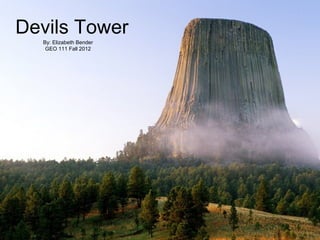
Brief Geography of Devils Tower
- 1. Devils Tower By: Elizabeth Bender GEO 111 Fall 2012
- 2. Devils Tower Warning: Notice is hereby given that any person or persons who injure or destroy or, without specific authority from the Secretary of the Interior, excavate or appropriate any historic or prehistoric ruin, monument, object of antiquity, or of scientific interest, for the protection of which this reservation was created, will be subject to arrest and punishment under the provisions of the acts of Congress approved February 6, 1905, and Jun 8,1908.
- 3. The Basics Approximately 300 miles north of Cheyenne, Wyoming, lies American's first National Monument.
- 4. The Basics It stands 1,270 feet above the Belle Fourche River below, and measures 180 feet east to west and 300 feet north to south.
- 5. The neighborhood There are three named layers of sedimentary rocks exposed at the base of Devils Tower.
- 6. The neighborhood The oldest layer at the bottom is called the Spearfish Formation, named after the town Spearfish, South Dakota. This layer was formed during the Triassic Epoch approximately 240 million years ago, when most of the surrounding area was part of the sea. The composition of the Spearfish Formation includes mudstones and sandstones.
- 7. The neighborhood The middle layer is known as the Gypsum Springs Formation and is mostly gypsum. It was formed during the Jurassic Epoch 150 million years ago. Gypsum is formed in natural saline waters.
- 8. The neighborhood The final layer of Devils Tower is the Sundance Formation. This is the youngest formation of the monolith, forming relatively shortly after the Gypsum Springs Formation. The layer is named after the Sundance Sea in which it was deposited and ripple marks from receding water can still be seen within this layer.
- 9. Formation Devil's Tower is an igneous rock formation created by intrusion. Igneous intrusion occurs when magma solidifies before it breaks through Earth's crust. The layer above the intrusion is pushed skyward creating, in this case, a massive bulge under the sedimentary rock crust. As the magma cooled, it shrank it size, forming the four, five, six, even seven sided pillars of Devils Tower. As the continents shifted and water eroded away the sedimentary layers, the phonolitic porphyry monolithic pluton was exposed. Geologist believe that while Devils Tower formed from cooling magma 50 million years ago during the Eocene Epoch, but it was not exposed until 1-2 million years ago.
- 10. Additional Research Needed Other theories state that Devils Tower is a laccolith or a volcanic neck. Geologists argue that Devils Tower would be much larger than it is if it were a laccolith, and there is no evidence of volcanic activities in the last 50 million years in the area. Click to watch
- 11. Weathering & Erosion 101 The 1,000 feet of sedimentary layers have eroded over the last 1-2 million years exposing the much harder igneous rock below. Some layers washed away with the receding Sundance Sea. Water of the Belle Fourche River Valley have washed away the loose soil and the eroded debris from the damaging rain and snow. Erosion exposed the monolith as it stands today. Frost wedging continues to break off small pieces that are swept away by water, wind, or people.
- 12. Erosion of Arid Land Wyoming, though once a body of water, is now a relatively arid land. The base of Devils Tower shows evidence of differential weathering and erosion. The sedimentary layers remaining at the base have eroded much faster than the igneous rock tower above. This has created the different slope and the dramatic distinction between the two types. The obviousness of the impressive change between the igneous and sedimentary layers is due to the arid climate of Wyoming.
- 13. Erosion of Arid Land The wind has also affected areas of Devils Tower. The monolith and surrounding areas are subject to deflation and abrasion. Dry particles are blown away, in deflation, and deposited miles away. Sands that are swept away don't leave without abrading the solid surfaces. These Aeolian processes are not as destructive as water, but signs Click to are prevalent at Devils Tower watch and evidence can be found in the surrounding areas of Aeolian deposited particles.
- 14. Very Brief Human Geography Before it was named a national monument, Devils Tower was believed to be formed by the claws of a giant bear as it was chasing two girls of the native Crow Tribe. A spirit made the rock grow until the bear could no longer reach them. 1906 FDR made Devils Tower America’s first national monument.
- 15. Very Brief Human Geography In 1977, Steven Spielberg directed “Close Encounters of the Third Kind,” a movie about UFOs and supernatural activities surrounding the monolith.